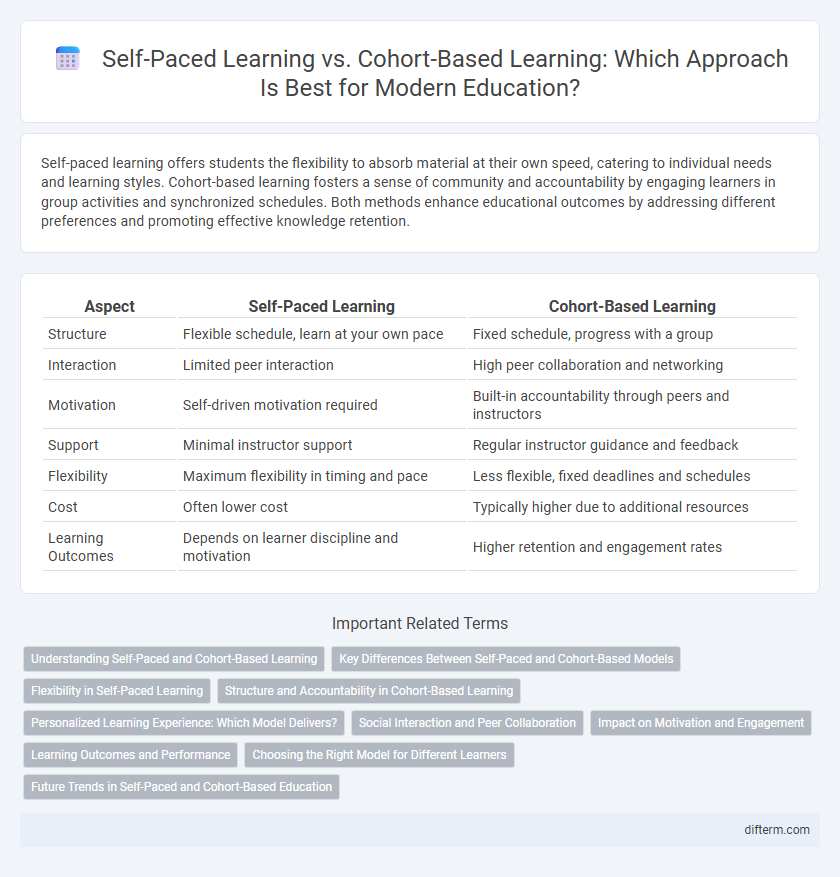Self-paced learning offers students the flexibility to absorb material at their own speed, catering to individual needs and learning styles. Cohort-based learning fosters a sense of community and accountability by engaging learners in group activities and synchronized schedules. Both methods enhance educational outcomes by addressing different preferences and promoting effective knowledge retention.
Table of Comparison
| Aspect | Self-Paced Learning | Cohort-Based Learning |
|---|---|---|
| Structure | Flexible schedule, learn at your own pace | Fixed schedule, progress with a group |
| Interaction | Limited peer interaction | High peer collaboration and networking |
| Motivation | Self-driven motivation required | Built-in accountability through peers and instructors |
| Support | Minimal instructor support | Regular instructor guidance and feedback |
| Flexibility | Maximum flexibility in timing and pace | Less flexible, fixed deadlines and schedules |
| Cost | Often lower cost | Typically higher due to additional resources |
| Learning Outcomes | Depends on learner discipline and motivation | Higher retention and engagement rates |
Understanding Self-Paced and Cohort-Based Learning
Self-paced learning allows students to progress through material at their own speed, offering flexibility and personalized mastery of content, which supports diverse learning styles and schedules. Cohort-based learning involves a structured timeline where learners progress together, fostering collaboration, peer support, and accountability that can enhance motivation and engagement. Understanding these models helps educators design curricula that balance individualized pacing with social interaction to optimize learning outcomes.
Key Differences Between Self-Paced and Cohort-Based Models
Self-paced learning empowers individuals to progress through educational content at their own speed, offering flexibility and personalized scheduling that caters to diverse learning styles. Cohort-based learning structures education around a fixed timeline with peer interaction, fostering collaboration, accountability, and a sense of community. The key differences lie in pacing control, social engagement, and the degree of instructor-led guidance, which significantly impact learner motivation and outcomes.
Flexibility in Self-Paced Learning
Self-paced learning offers unparalleled flexibility, enabling students to tailor their study schedules around personal and professional commitments without the pressure of fixed deadlines. This individualized approach enhances retention by allowing learners to progress at a comfortable speed, revisiting complex concepts as needed. In contrast, cohort-based learning requires synchronized participation, which may limit adaptability but fosters real-time collaboration and accountability.
Structure and Accountability in Cohort-Based Learning
Cohort-based learning provides a structured schedule with fixed deadlines that foster consistent progress and reduce procrastination among learners. The presence of peers and instructors creates a strong sense of accountability, encouraging active participation and timely completion of assignments. Unlike self-paced learning, this framework enhances motivation through collaborative engagement and peer feedback, leading to improved retention and outcomes.
Personalized Learning Experience: Which Model Delivers?
Self-paced learning provides a personalized learning experience by allowing students to progress according to their individual strengths and schedules, fostering autonomy and deep comprehension. Cohort-based learning promotes collaboration and peer interaction, which can enhance motivation and accountability but may limit flexibility. Data shows that self-paced models often lead to higher learner satisfaction and retention due to tailored pacing and content adaptation.
Social Interaction and Peer Collaboration
Self-paced learning offers flexibility but often limits opportunities for social interaction and peer collaboration, which are crucial for developing communication skills and deeper understanding. Cohort-based learning fosters a structured environment where learners engage in real-time discussions, group projects, and peer feedback, enhancing motivation and accountability. Studies show that active peer collaboration in cohort settings correlates with higher retention rates and improved critical thinking abilities.
Impact on Motivation and Engagement
Self-paced learning enhances motivation by allowing learners to progress according to their individual schedules, fostering a sense of autonomy and personal accountability. Cohort-based learning boosts engagement through collaborative activities, peer interactions, and structured timelines that create a dynamic learning community. Studies show that combining both models can maximize learner motivation and sustain long-term engagement by balancing flexibility with social support.
Learning Outcomes and Performance
Self-paced learning enables individualized progress aligned with personal comprehension speed, often resulting in higher retention and mastery of material. Cohort-based learning fosters collaborative engagement, promoting motivation and accountability that can enhance performance through peer interaction. Studies indicate that while self-paced learners achieve deeper conceptual understanding, cohort-based environments improve critical thinking and application through shared experiences.
Choosing the Right Model for Different Learners
Self-paced learning offers flexibility and personalized pacing, ideal for independent learners who require autonomy and time to absorb material deeply. Cohort-based learning fosters collaboration and structured timelines, benefiting learners who thrive on social interaction and peer accountability. Selecting the right model depends on individual learning preferences, motivation levels, and the need for community support in the educational journey.
Future Trends in Self-Paced and Cohort-Based Education
Future trends in education indicate a growing integration of AI-powered adaptive technologies in self-paced learning, enabling personalized pathways that boost engagement and retention. Cohort-based learning is evolving through hybrid models, combining synchronous collaboration with asynchronous resources to foster flexible yet connected experiences. The rise of data-driven analytics enhances both formats by providing real-time insights into learner progress and optimizing instructional strategies.
self-paced learning vs cohort-based learning Infographic

 difterm.com
difterm.com